
The new UNE 0081 Data Quality Assessment specification, focused on data as a product (datasets or databases), complements the UNE 0079 Data Quality Management specification, which we analyse in this article, and focuses on data quality management processes. Both standards 0079 and 0081 complement each other and address data quality holistically:
- The UNE 0079 standard refers to the processes, the activities that the organisation must carry out to guarantee the appropriate levels of quality of its data to satisfy the strategy that the organisation has set itself.
- On the other hand, UNE 0081 defines a data quality model, based on ISO/IEC 25012 and ISO/IEC 25024, which details the quality characteristics that data can have, as well as some applicable metrics. It also defines the process to be followed to assess the quality of a particular dataset, based on ISO/IEC 25040. Finally, the specification details how to interpret the results obtained from the evaluation, showing concrete examples of application.
How can an organisation make use of this specification to assess the quality level of its data?
To answer this question, we will use the example of the Vistabella Town Council, previously used in previous articles. The municipality has a number of data sets, the quality of which it wants to evaluate in order to improve them and provide a better service to citizens. The institution is aware that it works with many types of data (transactional, master, reference, etc.), so the first thing it does is to first identify the data sets that provide value and for which not having adequate levels of quality may have repercussions on the day-to-day work. Some criteria to follow when selecting these sets can be: data that provide value to the citizen, data resulting from a data integration process or master view of the data, critical data because they are used in several processes/procedures, etc.
The next step will be to determine at which point(s) in the lifecycle of the municipality's operational processes these data quality checks will be performed.
This is where the UNE 0081 specification comes into play. The evaluation is done on the basis of the "business rules" that define the requirements, data requirements or validations that the data must meet in order to provide value to the organisation. Some examples are shown below:
- Citizens' ID cards will have to comply with the specific syntax for this purpose (8 numbers and one letter).
- Any existing date in the system shall follow the notation DD-MM-YYYYYY.
- Records of documentation dated after the current date will not be accepted.
- Traceability of who has made a change to a dataset and when.
In order to systematically and comprehensively identify the business rules that data has to comply with at each stage of its lifecycle, the municipality uses a methodology based on BR4DQ.
The municipality then reviews all the data quality characteristics included in the specification, prioritises them, and determines a first set of data quality characteristics to be taken into account for the evaluation. For this purpose, and in this first stage, the municipality decided to stick exclusively to the 5 inherent characteristics of ISO 25012 defined within the specification. These are: accuracy, completeness, consistency, credibility and timeliness.
Similarly, for each of these first characteristics that have been agreed to be addressed, possible properties are identified. To this end, the municipality finally decided to work with the following quality model, which includes the following characteristics and properties:
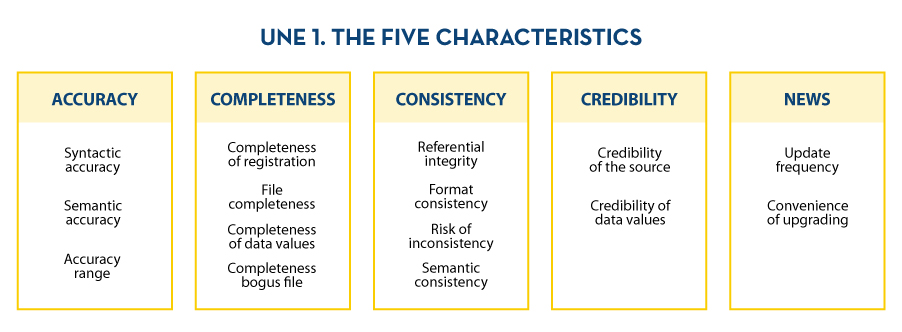
At this point, the municipality has identified the dataset to be assessed, as well as the business rules that apply to it, and which aspects of quality it will focus on (data quality model). Next, it is necessary to carry out data quality measurement through the validation of business rules. Values for the different metrics are obtained and computed in a bottom-up approach to determine the level of data quality of the repository
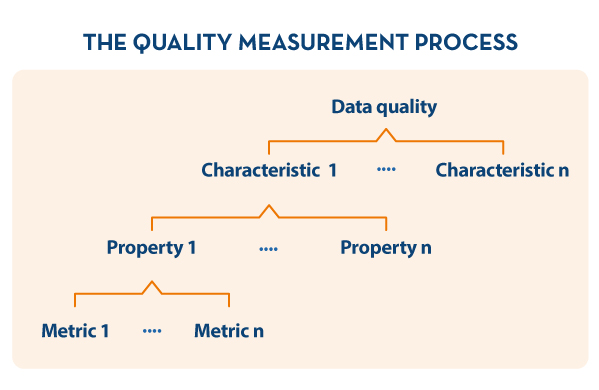
Definition of the evaluation process
In order to carry out the assessment in an appropriate way, it is decided to make use of the quality assessment process based on ISO 25024, indicated in the UNE 0081 specification (see below).
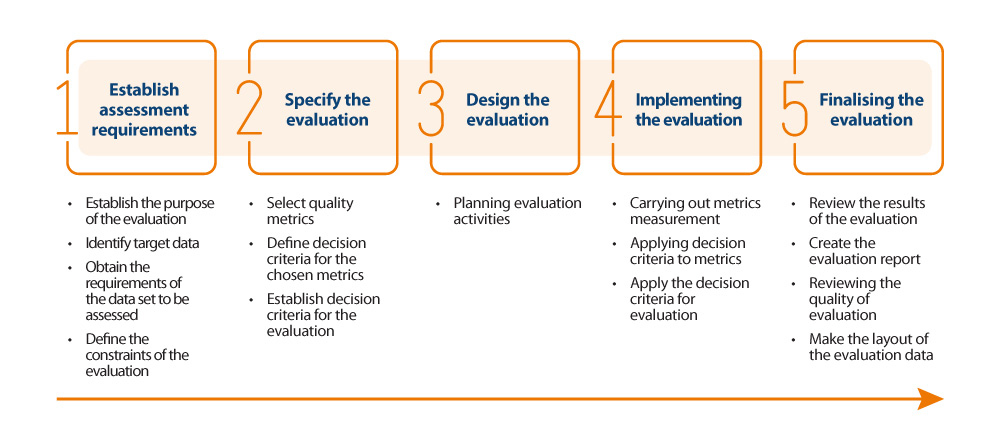
Implementation of the evaluation process
The following is a summary of the most noteworthy aspects carried out by the City Council during stage 4 of the evaluation process:
- Validation of the degree of compliance with each business rule by property: Having all the business rules classified by property, the degree of compliance with each of them is validated, thus obtaining a series of values for each of the metrics. This is run on each of the data sets to be evaluated.
As an example, for the syntactic accuracy property, two metrics are obtained:
- Number of records that comply with the syntactic correctness business rules: 826254
- Number of records that must comply with the syntactic correctness business rules: 850639
- Quantification of the value of the property: From these metrics, the value of the property is quantified and determined using the measurement function specified in the UNE 0081 specification. For the specific case of syntactic accuracy, it is determined that a record density of 97.1% complies with all syntactic accuracy rules.
- Calculation of the characteristic value: This is done by making use of the results of each of the data quality metrics associated with a property. To calculate it, and as specified in the UNE 0081 specification, it is decided to follow a weighted sum in which each property has the same weight. In the case of Accuracy, Syntactic Accuracy values are available: 97.1, Semantic accuracy: 95, and Accuracy range: 92.9. Computing these 3 scores, a value of 95 out of 100 was obtained for this characteristic.
- Shift from quantitative to qualitative value: In order to provide a final quality result, it is decided to use another weighted sum; in this case, all dimensions have the same weight. Based on the above aggregated results of the above characteristics: Accuracy: 95, Completeness: 87, Consistency: 90, Credibility: 88, News: 93, a quality level of 90 out of 100 is determined for the repository. Finally, it is necessary to move from this quantitative value of 0 to 100 to a qualitative value. In this particular example, using the percentage-based quality level function, it is concluded that the quality level of the repository, for the analysed property, is 4, or "Very Good".
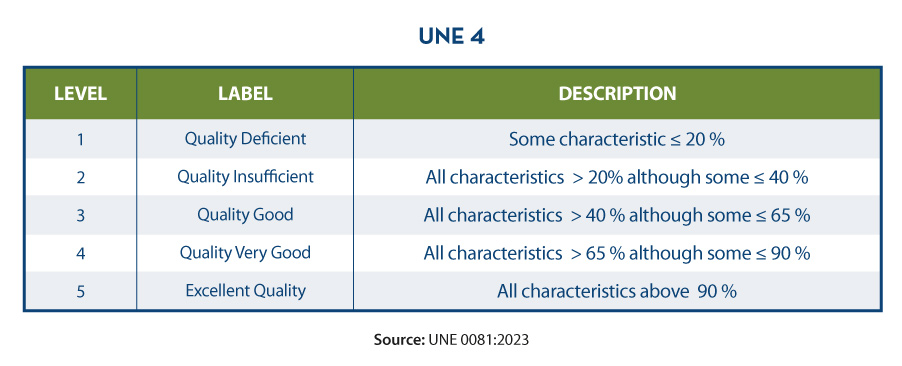
Results visualisation
Finally, once the evaluation of all the characteristics has been carried out, the municipality builds a series of data quality control dashboards with different levels of aggregation (characteristic, property, dataset and table/view) based on the results of the evaluation, so that the level of quality can be quickly consulted. For this purpose, results at different levels of aggregation are shown as an example.
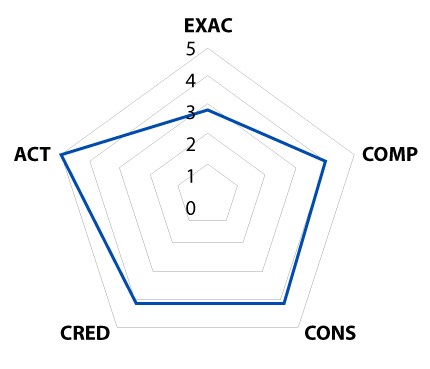
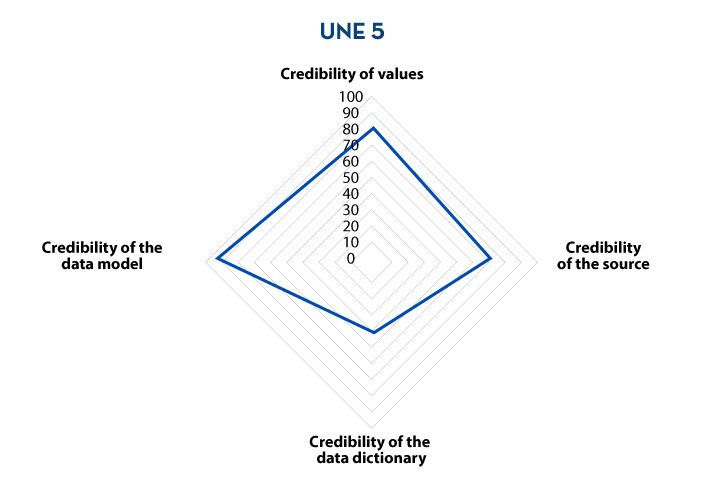
As can be seen throughout the application example, there is a direct relationship between the application of this UNE 0081 specification, with certain parts of the 0078 specification, specifically with the data requirements management process, and with the UNE 0079specification, at least with the data planning and quality control processes. As a result of the evaluation, recommendations for quality improvement (corrective actions) will be established, which will have a direct impact on the established data processes, all in accordance with Deming's PDCA continuous improvement circle.
Once the example has been completed, and as an added value, it should be noted that it is possible to certify the level of data quality of organisational repositories. This will require a certification body to provide this data quality service, as well as an ISO 17025 accredited laboratory with the power to issue data quality assessment reports.
The content of this guide can be downloaded freely and free of charge from the AENOR portal through the link below by accessing the purchase section. Access to this family of UNE data specifications is sponsored by the Secretary of State for Digitalization and Artificial Intelligence, Directorate General for Data. Although the download requires prior registration, a 100% discount on the total price is applied at the time of finalizing the purchase. After finalizing the purchase, the selected standard or standards can be accessed from the customer area in “my products” section.
Content prepared by Dr. Fernando Gualo, Professor at UCLM and Data Governance and Quality Consultant.The content and the point of view reflected in this publication are the sole responsibility of its author.